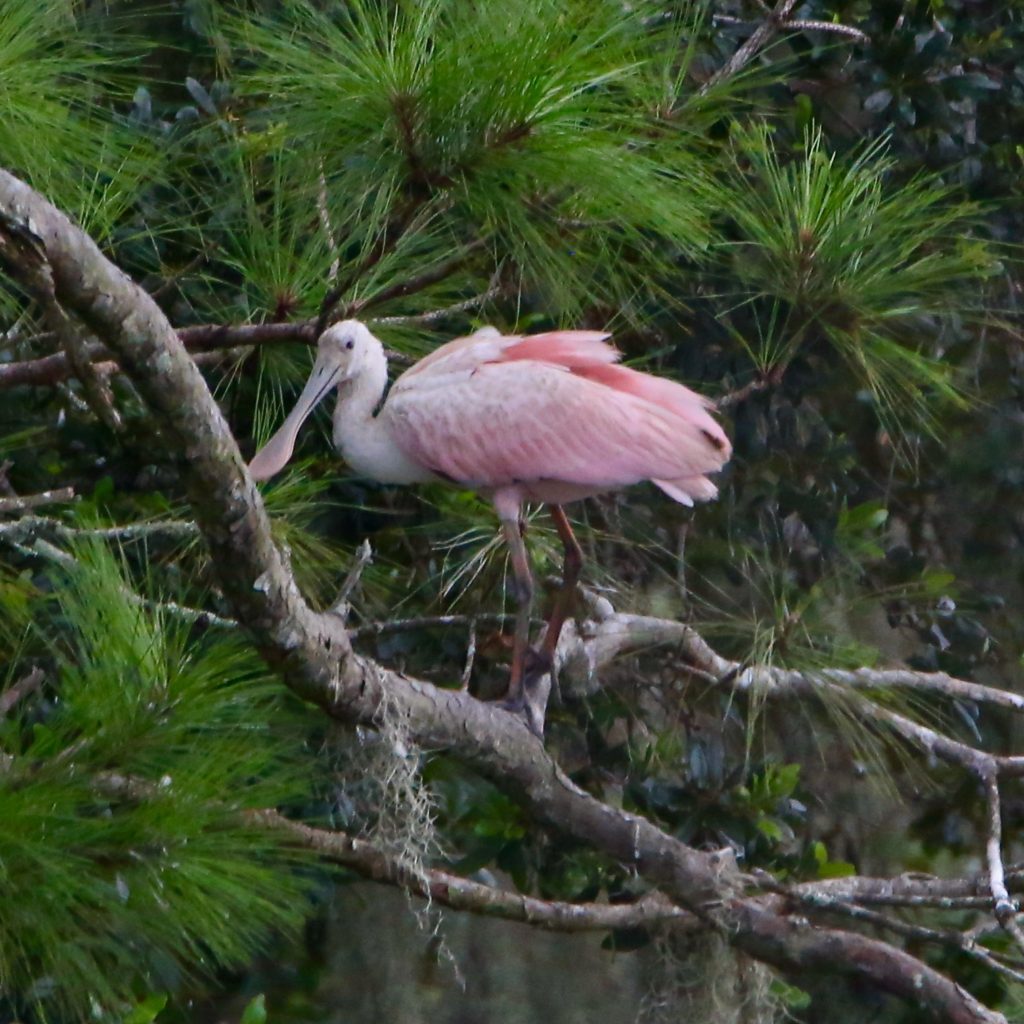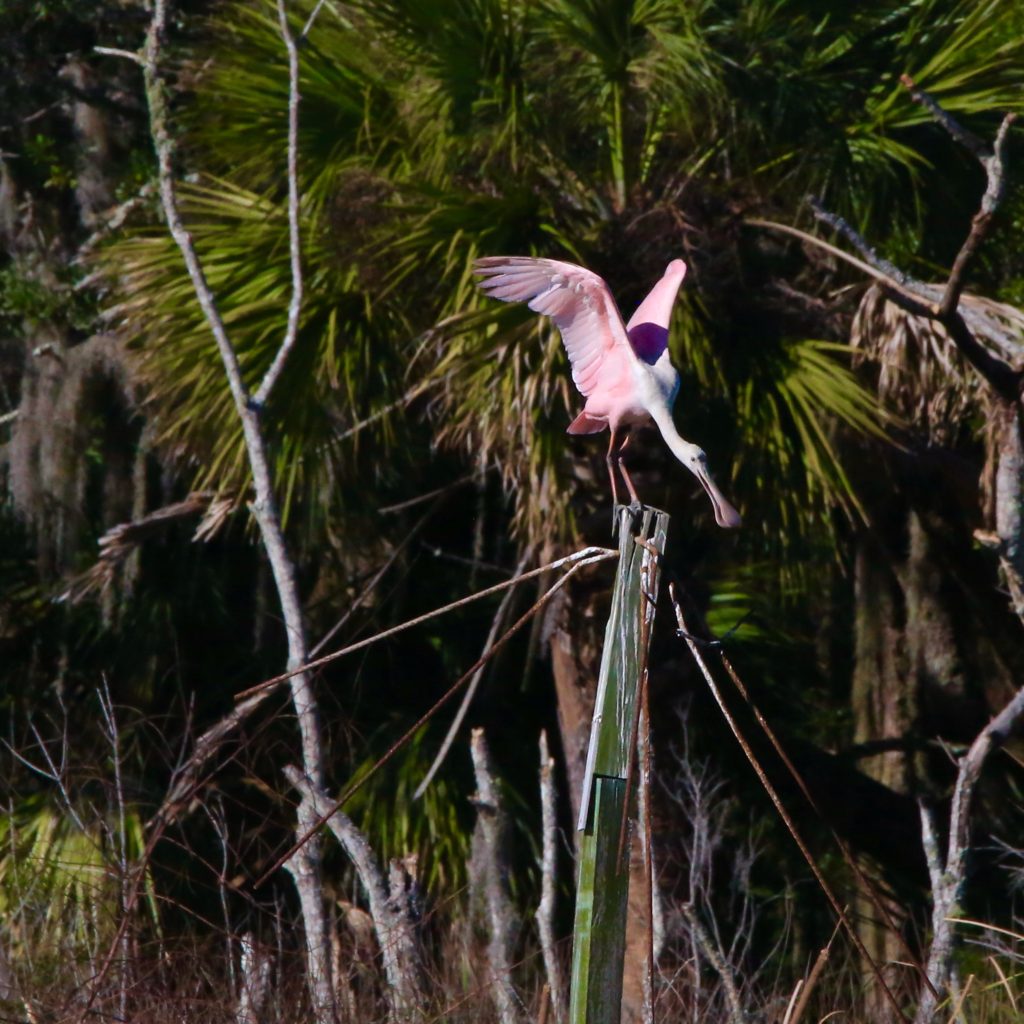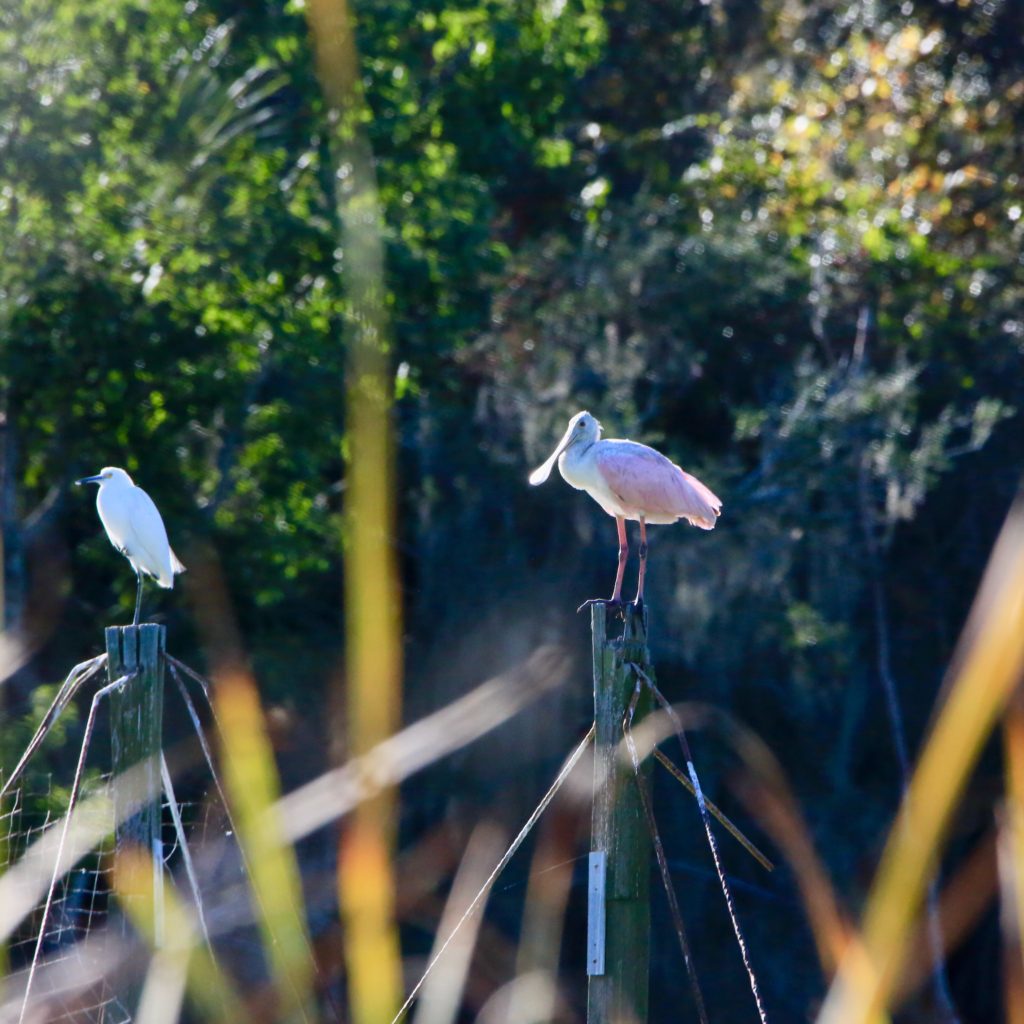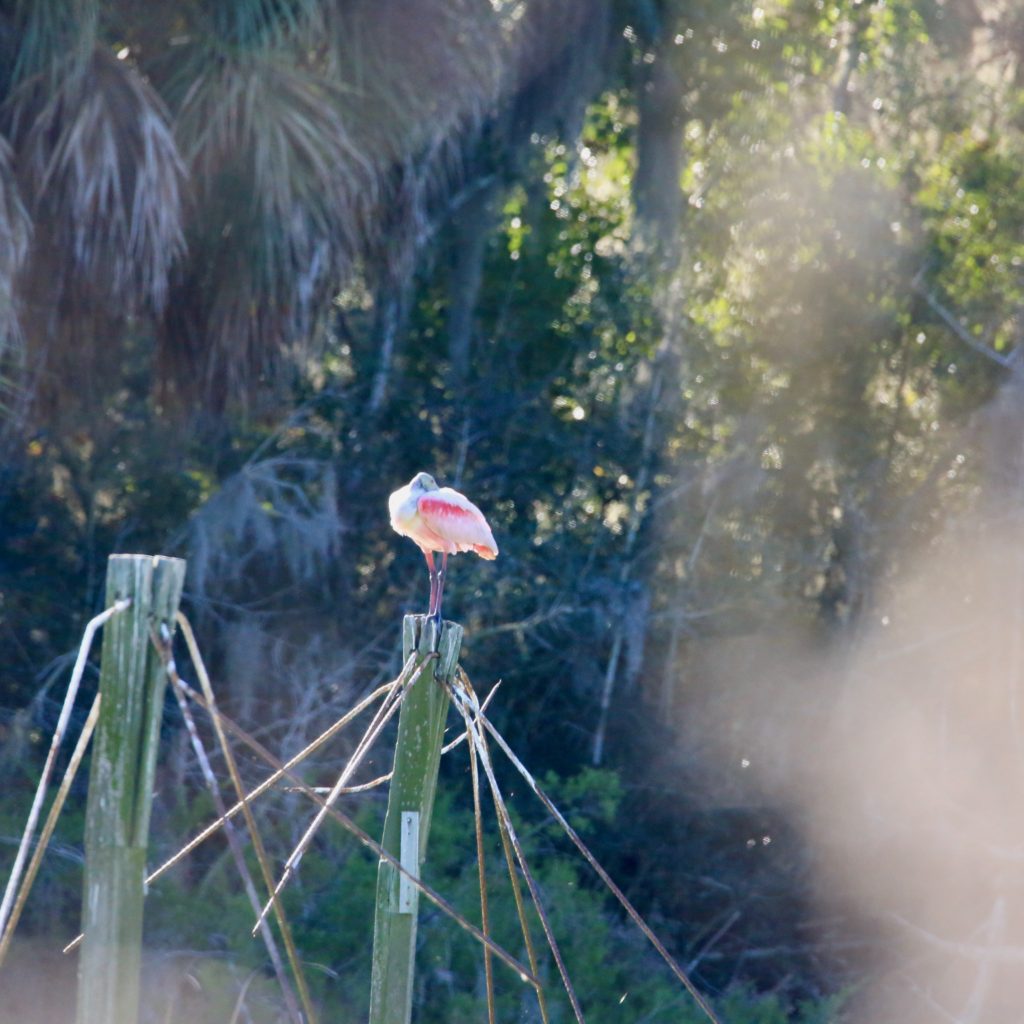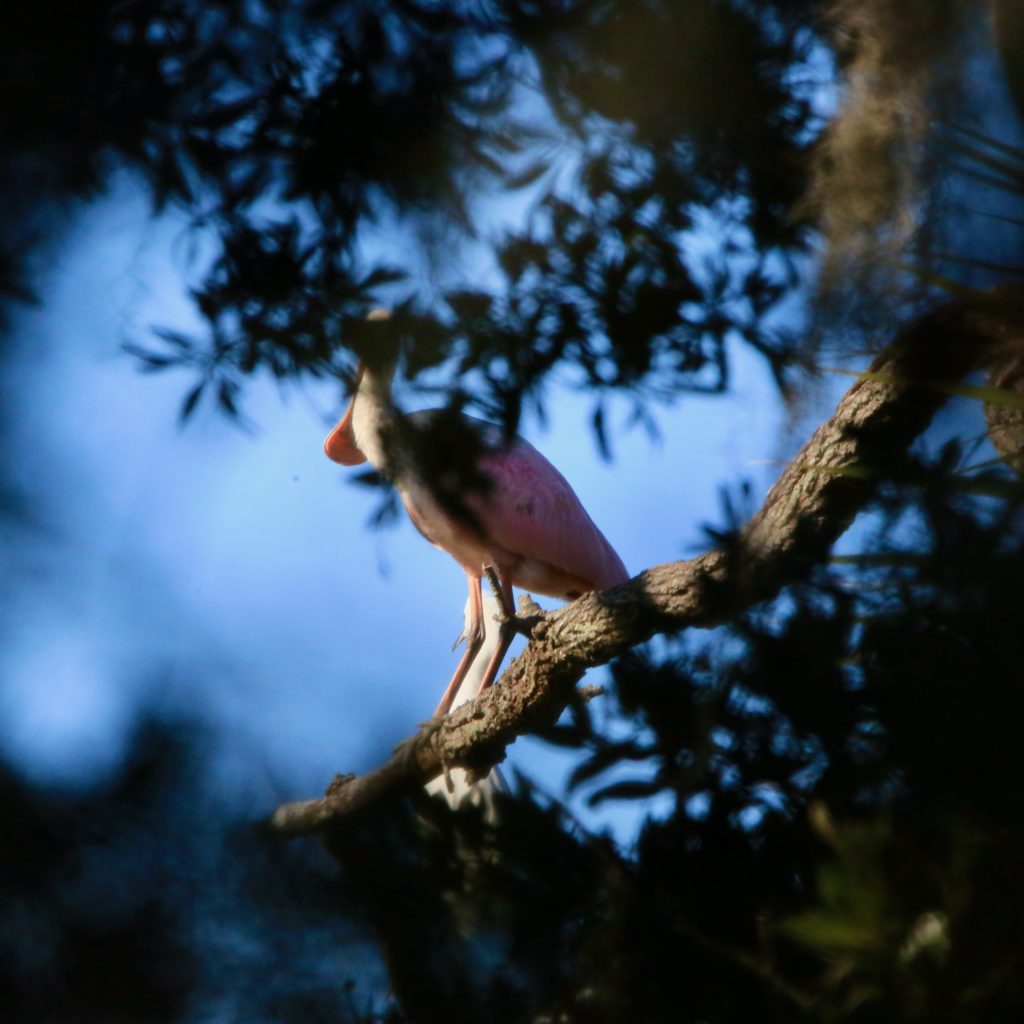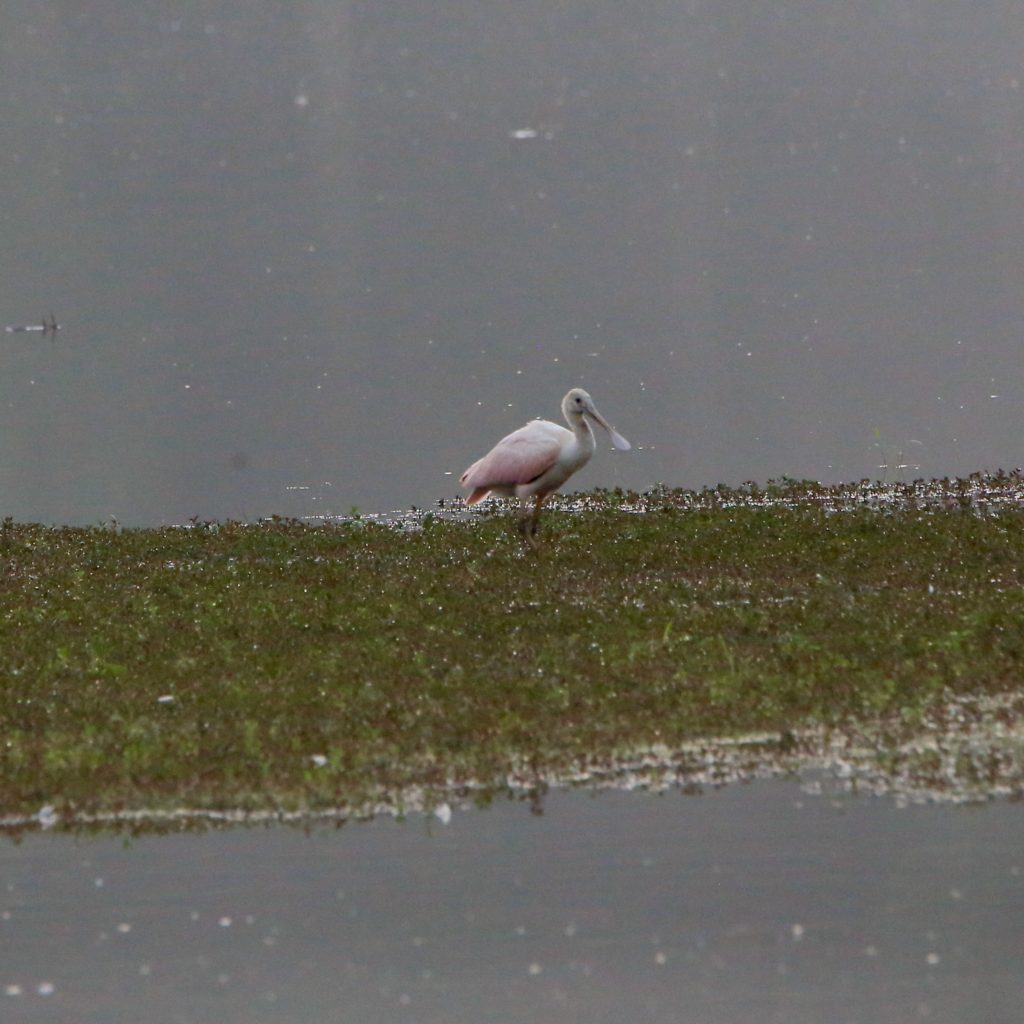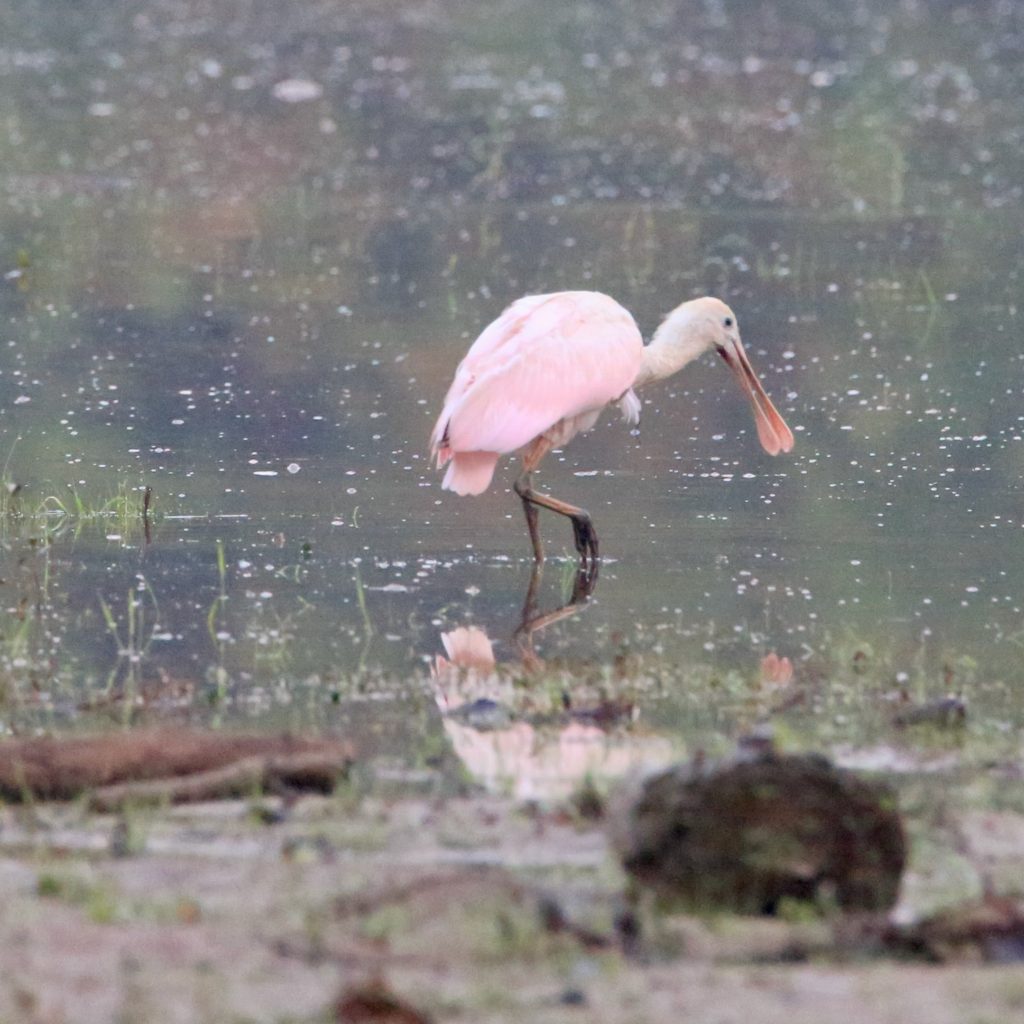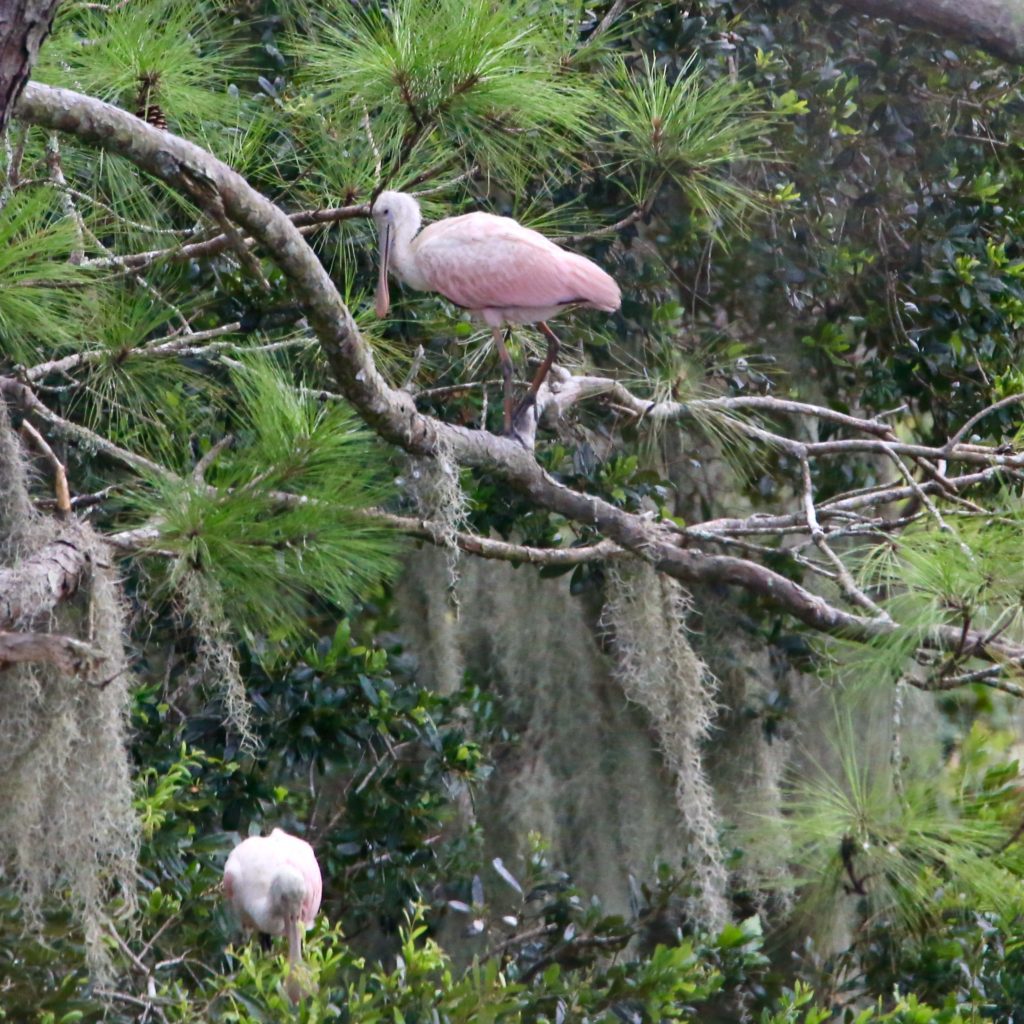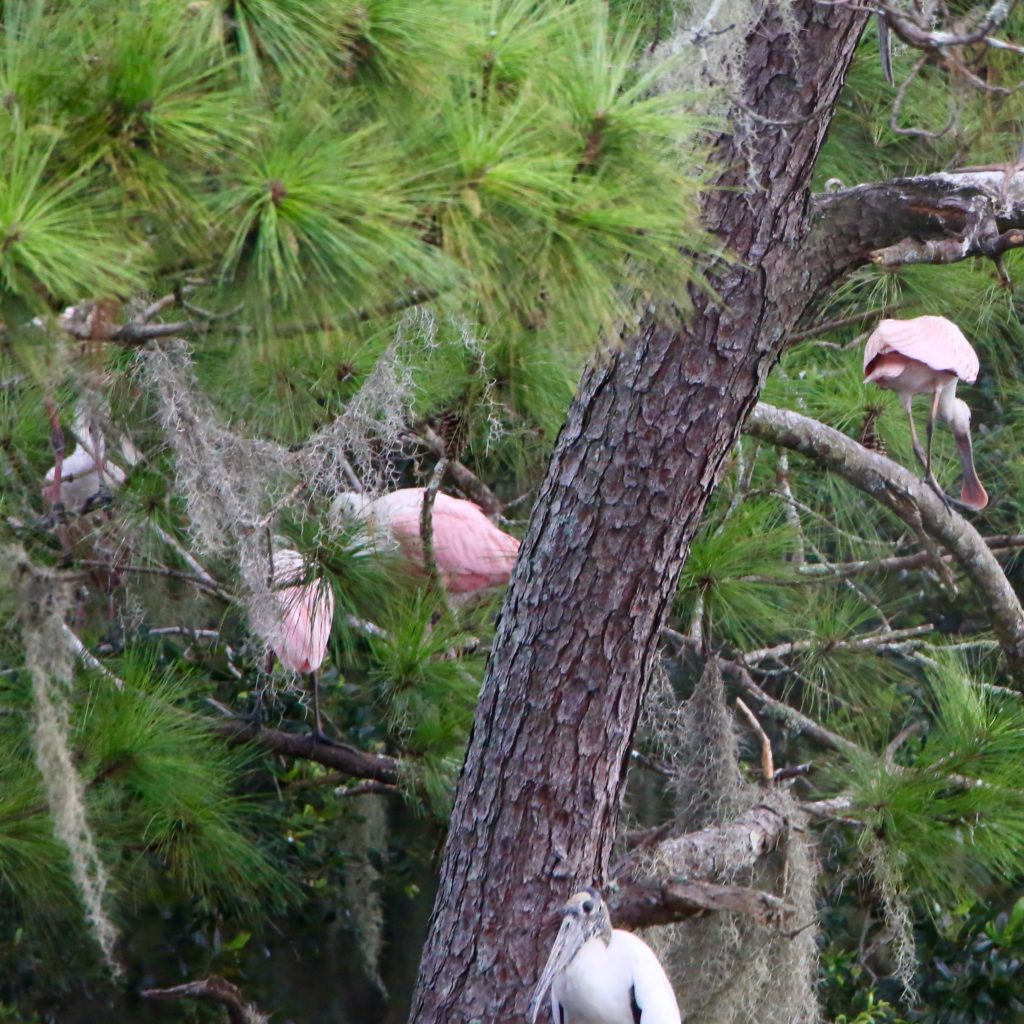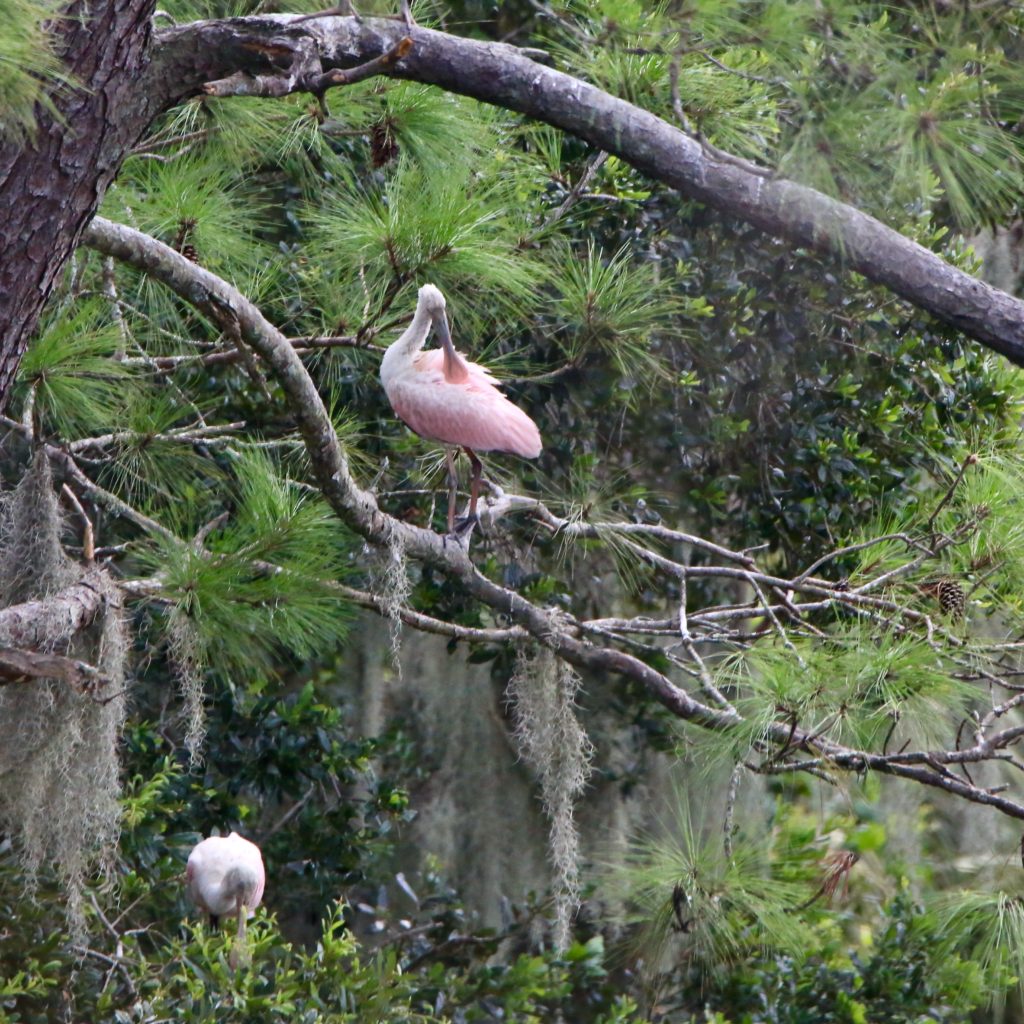
Belonging to the Ibis and Spoonbill family, Roseate Spoonbill is a lucky sight for anyone interested in bird watching. Especially for passionate birdwatchers, the large wading birds with their pink plumage certainly make for amazing pictures. We’ve compiled a list of information that will help you identify Roseate Spoonbill with ease.
About Roseate Spoonbills
Roseate Spoonbills are what one would call middle-sized wading birds who belong to the Spoonbill and Ibis family. They are known to be bigger than White Ibises while Great Blue Herons tower over them. What’s funny is that all of these bird species live in harmony and share the same colony, which we will learn about further down among other Roseate Spoonbill facts.
Their genus is somewhat separated from others, and is known as Ajaja. A study concluded that Roseate Spoonbills and Yellow Billed Spoonbills can be termed the closest relatives of each other. The study examined the mitochondrial DNA of both the species of Spoonbills. They are both descendants of at least four other species of Spoonbills. The genetic evidence puts all six under the genus Platalea, with Roseate Spoonbill getting its distinct Ajaja genus. Morphologically, the six species are close, which makes sense to group them under a single genus. However, there are still people that would consider Roseate Spoonbills specifically under Ajaja.
Roseate Spoonbills Color Pattern
In the case of baby Roseate Spoonbill or Juvenile Roseate Spoonbill, they have a really pale pink plumage. The best way to describe the color is cotton candy pink, but even lighter. The feathered head has a white color, though it still has a slight shade of pink.
Adult Roseate Spoonbill has a darker shade of pink on its plumage. The shoulders of the Adult Roseate Spoonbill are almost red, while the head is a mix of green and yellow color.
Roseate Spoonbill Size
Lengthwise, Roseate Spoonbills tend to be about 71 cm to 86 cm. At most, Roseate Spoonbills can be about 63.5 oz in weight, while their lowest weight is around 42.3 oz. Also, their wing spans from 47.2 inches to 51.2 inches.
As such, Roseate Spoonbills are what one considers medium-sized. Their body is somewhat football-shaped followed by long legs. Although the head is small, the bill is quite long, with the tip flattening out in the shape of a spoon. When they have their neck- which is long- outstretched, they appear taller. Usually, though, they prefer tucking it in, leading to an S-shaped of the neck.
Roseate Spoonbill Behavior
Roseate Spoonbill prefers shallow water areas. They dip their bill into the water and walk through the narrow water streams, all the while swinging their heads. They do so in the hopes of coming across their prey underwater. Their hunt for food usually has their body bent horizontally while their head hangs low. Their body doesn’t touch the water, except their legs and bills.
When they fly, they have their neck extended, though it’s not in a straight line and instead dips a little. Their wingbeat is slow, but they stroke deep with their wings, leading to a steady flight. If they are in the middle of foraging and see other Spoonbills flying in the air, they turn their neck and bill upward, looking straight at them. This posture of theirs is termed as sky gazing.
Roseate Spoonbill doesn’t seem to mind cooperation with other birds. They are extremely social and are often seen in gatherings with a bird count of 400. Not only do they look for food with other Roseate Spoonbills that are not their mates, they are also seen foraging with Egrets, Herons, and Ibises. They also don’t mind sharing their roosting and nesting colonies with these birds.
One of the colonial habits of Roseate Spoonbills involves bobbing the heads up and down in case of male Spoonbills while they shake any twigs they have nearby to get the attention of a female Spoonbill. When the interest is mutual, a pair may show it by biting each other’s bill, or they might extend their wings and raise it in the air. Once the pairing is complete, male Spoonbills offer sticks to female Spoonbills with their bills. Generally, though, the pairing doesn’t last more than the breeding season.
When they are in the middle of feeding, a low sound comes out of them. It sounds aggressive, and it comes up from their guts. Their call is also heard when they fly or are in the middle of their elaborate displays while breeding.
Their sleeping posture is particularly interesting, as they do so while standing. They usually only stay on one leg while singing while the other is tucked upward and the head is usually tucked in.
What Roseate Spoonbill Eat
As Roseate Spoonbill tends to prefer shallow waters while looking for food, what they get are usually aquatic fish and insects, prawns, shrimps, and other such crustaceans. Their bills stay parted while they are sweeping through the water. Once their bills touch the prey, they close their bills immediately. Often, they end up swallowing the prey whole, without any ceremony to it.
Roseate Spoonbills that live in Smithsonian’s National Zoo even get slightly more gourmet food such as sea duck pellets, insects, and flamingo pellets.
Where Roseate Spoonbill Live
The Roseate Spoonbill habitat mainly consists of freshwater and marine waters, always in the shallow areas. Their choice for these water bodies is obvious. They prefer habitats with a good aquatic collection of invertebrates they can feed on. This can mean from mangroves and bays to swamps in the forest or even ditches with water on the road. For nesting, they prefer the trees that are right along the edge of the river bodies.
The Roseate Spoonbill range is particularly difficult to estimate since they prefer any kind of shallow water body with trees around them, but at most, you should be able to find them on the coasts of the Southeast US. Roseate Spoonbill Florida sighting is still common, or if you go even further, like Mexico or South America in general, you might spot some. Especially in Florida, a lot of the Roseate Spoonbills are found in protected areas. In Florida, Texas, and Louisiana, you will find Roseate Spoonbills mainly on the coasts.
In general, the population of Roseate Spoonbill is thought to be high, though it is impossible to get a proper estimate. They aren’t an endangered species, and while their habitat makes it difficult to spot them, they aren’t low in number. If you do manage to see them, you might see a large group all at once because of their social nature.
Range and Migration
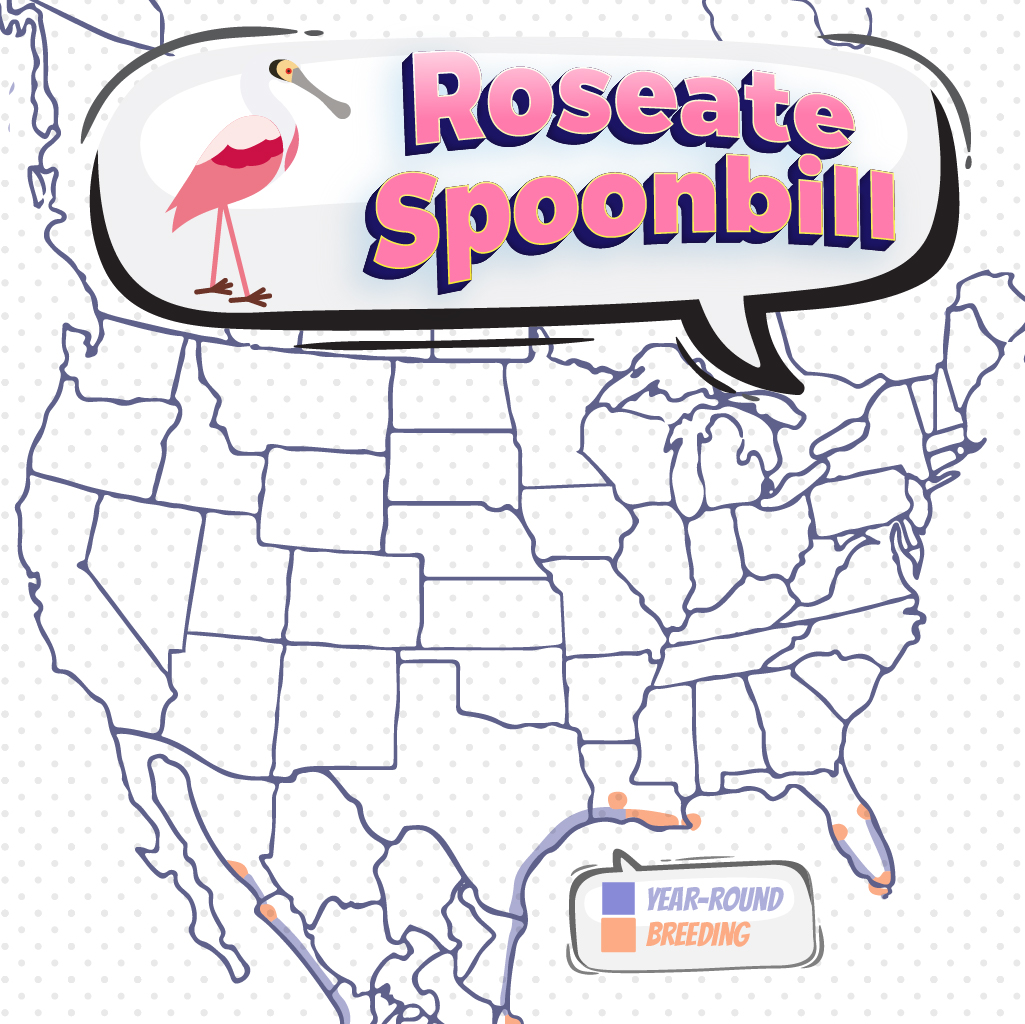
Roseate Spoonbill Lifecycle
We have already talked about how Roseate Spoonbills like staying in colonials. They are what we call Colonial nesters. This basically means that for producing and raising their young, they tend to gather up in big numbers with other birds. This is possible to provide protection to their young ones as well, there is power in numbers.
It takes about age 3 to before a Roseate Spoonbill is considered an adult. At this age, they leave their parents’ nest and migrate to a nesting ground they find appropriate in the hopes of finding a mate of their own. It is interesting to note that while they are happy to find a mate and breed with them, none of them stay with their mate for more than one breeding period.
Once they find a mate on the coasts, both the male and female help each other construct a nest in a tree they like. Sometimes, they might choose bushes to make their nests on instead. Typically, it takes them 3 years before they are ready to breed. In their courtship period, they will exchange nest material with each other, dance, or clap to keep the attention of their mate. Female Spoonbills use the stick materials brought by their male counterparts to make nests that are very properly constructed.
In these nests, two to four legs are laid in a clutch. The male and female Spoonbills take turns incubating the eggs. It takes about 3 weeks for the eggs to start hatching. For the eggs to fledge, it takes somewhere from around 35 to 42 days. So, in total, it takes about an entire month.
The male and female Spoonbills don’t mind feeding their chicks until they turn eight weeks old at least. At a young age, the Roseate Spoonbills have a white body with the slightest tinge of pink to them. Like we said, it is the cotton candy pink color at this stage. The colorful feathers that the adult Roseate Spoonbills have doesn’t show up until after a couple of years of their birth. By that, we mean it takes them 3 to 4 years to reach adulthood.
Afterward, if these Roseate Spoonbills end up in protected areas, that is, if they are under human care, they can live up to 15 years. If they continue to live in the wild without any extra protection, it takes about 10 years before they reach the end of their lifespan.
Ornithology
Anatomy of a Roseate Spoonbill
As far as North American birds go, Roseate Spoonbills are a particularly distinctive one. They are the kind of birds that once your eyes spot them you won’t be able to look away. Their plumage is usually pink, with sometimes crossing over to the red line. You can also spot some hot colors in their plumage. Their feathered tails are orange in color, while their eyes and legs are deep, dark red. Yet, their feet are usually black in color. You won’t find any difference in the color patterns of male and female Roseate Spoonbills though there are definite differences between the color patterns of juvenile and adult Spoonbills.
Similar to other wading birds, you would note that the legs of Roseate Spoonbills are particularly long. Yet, those legs are ridiculously thin. It makes one wonder how they balance their round, football-shaped body on it. However, an obvious advantage of their long legs is that they can trek on shallow waters without getting their head or body remotely wet.
We have already discussed the flat spoon-shaped bills of the Spoonbills but do you know it is particularly sensitive? It is this sensitivity that allows them to sense their prey at the slightest touch. Just at the top of the bills, there are two slits that are quite small. It is through these silts they are capable of breathing even while their beak is dipped underwater. They have a featherless head once they become adults, and the head has the lightest shade of green to it. It is the only color in their body that doesn’t match the overall pattern of colors they have had throughout their life, which is different shades of pink.
Final Thoughts
If you are a bird watcher yourself, you might be looking into Roseate Spoonbills to fulfill your collection of breathtaking photos of birds. Or maybe it is simply the curiosity and hunger of a bird lover wanting to see the birds they want to know everything about, to see them once and observe everything about them. Maybe you are looking forward to comparing the notes you have on them and seeing how much of it is true in prison.
Or you could be someone trying to get a child interested in bird watching as one of the best outdoor activities. In that case, Roseate Spoonbills is one of the best birds to start sparking their curiosity with. To do that though, along with showing children the Spoonbills and teaching them various facts, you might want to stock up on your merch collection. These days, the best way to keep the attention of a child is to give them something that they can show off to their friends!
Bird Watching Academy & Camp Subscription Boxes
At Bird Watching Academy & Camp we help kids, youth, and adults get excited and involved in bird watching. We have several monthly subscription boxes that you can subscribe to. Our monthly subscription boxes help kids, youth, and adults learn about birds, bird watching, and bird conservation.
Bird Watching Binoculars for Identifying Roseate Spoonbills
The most common types of bird watching binoculars for viewing Roseate Spoonbills are 8×21 binoculars and 10×42 binoculars. Bird Watching Academy & Camp sells really nice 8×21 binoculars and 10×42 binoculars. You can view and purchase them here.
Roseate Spoonbill T-shirts
If you love the Roseate Spoonbill you should purchase a Bird Watching Academy & Camp T-shirt. To help support bird conservation we donate 10 percent to bird conservation activities.
Roseate Spoonbill Iron On Patches
Kids, Youth, and Adults love to collect our Bird Watching Academy & Camp iron on patches. Our bird watching patches help you keep track of the birds you have seen an identified. You can also display the patches on our Bird Watching Academy & Camp banners.
The Roseate Spoonbill is a great iron on patch to start your collection with. The patches are durable and can be sewn on or ironed on to just about anything.
Roseate Spoonbill Stickers
Stickers are a great way for you to display your love for bird watching and the Roseate Spoonbill. We sell a monthly subscription sticker pack. The sticker packs have 12 bird stickers. These sticker packs will help your kids learn new birds every month.
Bird Feeders For Roseate Spoonbill
There are many types of bird feeders. Here are our favorite bird feeders for your backyard. We use all of these bird feeders currently. Kids will have a great time watching birds eat at these bird feeders. Using this collection of bird feeders will provide a wide variety and many types of birds.
Best Bird Houses for Roseate Spoonbill
There are many types of bird houses. Building a bird house is always fun but can be frustrating. These 4 bird houses have become our favorites. Getting a bird house for kids to watch birds grow is always fun. We spent a little extra money on these bird houses but they have been worth the higher price and look great.
Roseate Spoonbill Activities for Kids
We thought a fun perler bead pattern would be fun for kids. Please download and print with 100% scale to fit perfectly with perler bead patterns.




